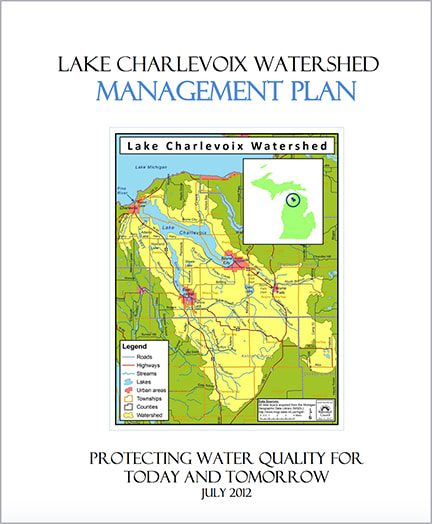|
Lake Charlevoix is one of Michigan's premier inland lakes. With a surface area of over 17,200 acres it is the third largest lake in Michigan. The beauty of Lake Charlevoix has attracted visitors for more than a century with its clean water, scenic shoreline, and superb fishing.
Lake Charlevoix collects water from a 214,400-acre Watershed. The Lake Charlevoix Watershed is predominantly forested. Lake Charlevoix Watershed includes: Lake Charlevoix, the Jordan River, Boyne River, Stover Creek, Horton Creek, Loeb Creek, Deer Creek, Porter Creek, and Monroe Creek. Beech/maple, white pine, and other upland forest account for just over 50% of the land in the Watershed. Wetlands are estimated to account for 22% of land use. Agricultural uses occupy approximately 15% of the land. The urban areas of Boyne City, Boyne Falls, Charlevoix, and East Jordan account for approximately 4% of the land use in the Watershed. The remaining 9% consists of water and other miscellaneous uses. Although this Watershed is still predominantly forested, development is occurring at a rapid pace reducing the amount of forests, agricultural lands, and wetlands. |
Lake Charlevoix Water Quality and Pollution
The water quality of Lake Charlevoix and its tributaries is currently good. Maintaining the good water quality (or improving it) requires ensuring activities in the Watershed don't contribute pollutants that can harm water quality. In an effort to reduce nonpoint source pollution, the Lake Charlevoix Watershed Project is focused on maintaining the following components of water quality:
Understanding which land use activities are contributing the most nutrient and sediment pollution to Lake Charlevoix and its tributaries is essential for determining how we can best protect our valuable Lake and rivers.
Nonpoint Source Pollution Inventories
Reducing the amount of nonpoint source pollution and preventing future contributions to Lake Charlevoix is essential to protecting the many high quality uses this resource provides including swimming, boating, and fishing. The proposal implementation activities for the Lake Charlevoix Watershed Project will work towards this goal.
The water quality of Lake Charlevoix and its tributaries is currently good. Maintaining the good water quality (or improving it) requires ensuring activities in the Watershed don't contribute pollutants that can harm water quality. In an effort to reduce nonpoint source pollution, the Lake Charlevoix Watershed Project is focused on maintaining the following components of water quality:
- Recreational Quality Support high water quality to encourage all forms of recreation - swimming, boating, and fishing - by reducing inputs of sediment, nutrients, and bacteria.
- Fishery Quality Sustain an excellent cold water fishery by reducing sediment and nutrient loads that can threaten fish habitat and result in higher water temperatures in the lake and its river tributaries.
- Habitat Quality Protect Watershed biodiversity by protecting vital aquatic plant and animal habitats from pollution.
- Navigational Quality Maintain lake and river tributary navigation by promoting methods to reduce all means of sediment input.
Understanding which land use activities are contributing the most nutrient and sediment pollution to Lake Charlevoix and its tributaries is essential for determining how we can best protect our valuable Lake and rivers.
Nonpoint Source Pollution Inventories
- Stormwater
- Shoreline Pollution
- Lakeshore Erosion
- Streambank Erosion
- Road/Stream Crossing
- Recreational Impact Assessment Agriculture
- Sensitive Areas Assessment
- Forestry
- Land Use/Cover Type
- Zoning
- Build-out Analysis
Reducing the amount of nonpoint source pollution and preventing future contributions to Lake Charlevoix is essential to protecting the many high quality uses this resource provides including swimming, boating, and fishing. The proposal implementation activities for the Lake Charlevoix Watershed Project will work towards this goal.
Lake Charlevoix Watershed Project Partners:
|
|
|




